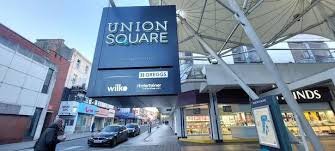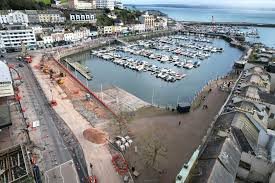Torquay
Buy-to-let Guide
Torquay is a picturesque coastal town in the heart of the English Riviera, South-West England. Known for its stunning seaside views, mild climate, and vibrant tourism, Torquay has become an increasingly popular destination to live, work, and visit. For those eyeing the buy-to-let market, Torquay presents a compelling investment opportunity. In this guide, we will explore the factors that make Torquay an appealing location for buy-to-let investors, from its flourishing tourism industry and growing local economy to its wide range of property options. You’ll also find insights into average property prices, projected growth, and rental yields. If you’re considering investing in Torquay’s buy-to-let market, discover why this coastal gem could be the ideal location for your next property venture.
Economy GVA £2.1 Billion
Population 139,000
Visitors Per Year 4.5 Million
Rental Growth 4%
Property Price Growth 4.5%
Want To Browse Property Deals?
Explore our exclusive portfolio of meticulously curated properties from across the UK, carefully selected for their exceptional growth potential and outstanding returns. Don’t settle for ordinary—contact us today to learn more!
Property Market Overview
The property market in Torquay features a diverse range of options, including Victorian villas, contemporary apartments, and charming seaside cottages. As of Q1 2025, the average property price in Torquay is approximately £360,000, significantly lower than the UK national average of over £400,000. Detached houses in Torquay average around £450,000, while flats are much more affordable, with average prices of £180,000.
Torquay’s affordability makes it particularly appealing to first-time landlords and investors looking for high-value opportunities. Areas such as Wellswood, known for its boutique shops and cafes, and Babbacombe, celebrated for its stunning views and beach access, are especially desirable for long-term residents and holidaymakers.
According to local estate agents, properties in these prime locations often experience higher demand and better retention rates, further enhancing their appeal to investors. Historical trends indicate consistent price growth over the past decade, underpinned by ongoing development and regeneration projects in the town. Given historical trends since 1995, the average property price growth per year is between 3% and 5%, and we have factored this in for the next five years leading up to 2030.
Tourism and Economy
Tourism is the backbone of Torquay’s economy, contributing significantly to local income and employment. The town’s unique blend of natural beauty, rich heritage, and recreational opportunities draws millions of visitors annually, sustaining a vibrant economy. Key statistics and attractions include:
Visitor Numbers and Economic Impact:
Torquay is part of the English Riviera, which attracts approximately 4.5 million visitors per year, generating over £500 million annually for the local economy. Tourism supports around 12,000 jobs across Torbay, making it a vital industry for the area.
The English Riviera Geopark:
Recognised as a UNESCO Global Geopark, this area showcases Torquay’s exceptional geological heritage, with highlights such as Kents Cavern, one of Europe’s most important Stone Age cave sites. It attracts nature enthusiasts, geologists, and educational groups from around the world.Agatha Christie’s Legacy:
Torquay proudly celebrates its connection to Agatha Christie, the world-famous author born in the town. The annual Agatha Christie Festival, themed tours, and landmarks like the Agatha Christie Mile bring literature enthusiasts and cultural tourists.Beaches and Watersports:
Torquay boasts some of the UK’s most iconic beaches, including Meadfoot Beach and Oddicombe Beach, which are Blue Flag-rated for their cleanliness and facilities. These beaches are popular for sunbathing, kayaking, paddleboarding, and sailing, supporting a thriving watersports industry.Cultural and Leisure Events:
The town hosts a variety of events year-round, from seafood festivals to live music performances, further boosting tourism. Venues like the Princess Theatre and Torre Abbey Museum provide cultural enrichment and entertainment for visitors and residents alike.
In addition to tourism, Torquay benefits from a growing retail and hospitality sector, with areas such as Fleet Street and Union Square offering a mix of independent boutiques, high-street stores, and dining options. Recent regeneration projects and government initiatives are also fostering emerging industries, diversifying the local economy and providing new opportunities for businesses and investors.
Rental Yields and Demand in Torquay
Torquay offers competitive rental yields, averaging between 4% and 5%, with select property types and prime locations achieving yields as high as 9%. This makes the town an attractive prospect for property investors seeking stable returns. The local rental market is shaped by two primary demand streams, though additional opportunities may exist depending on property type and location:
1. Long-Term Residential Tenants
Families and professionals are a cornerstone of Torquay’s rental market, drawn by the town’s coastal setting, strong sense of community, and excellent amenities. Areas such as Shiphay and Chelston are particularly desirable due to their proximity to high-performing schools, parks, and convenient transport links. These tenants typically prioritise well-maintained homes with practical layouts and access to local services, ensuring a steady demand for buy-to-let properties catering to this demographic.
2. Holiday Lets
As a year-round tourist destination, Torquay attracts millions of visitors annually, creating a lucrative market for short-term holiday lets. Properties near key attractions such as Torre Abbey, Kents Cavern, or within walking distance of the harbour and beaches can achieve significantly higher rental incomes during peak tourism seasons. Holiday lets often offer greater income potential than long-term rentals, though they require higher management involvement or letting agent support to handle bookings, cleaning, and seasonal upkeep.
Student Rental Market
Unlike cities with universities or large colleges, Torquay does not have a significant student population. This means the town lacks a defined market for student housing, which can affect rental yields in areas traditionally reliant on such tenants. However, smaller educational institutions, vocational colleges, or niche training facilities may still generate some localised demand. Investors considering student accommodation should research specific institutions and assess whether demand justifies a targeted approach.
Investment Considerations
Torquay’s rental market is primarily driven by lifestyle appeal and tourism, making it essential for investors to carefully match property types to tenant demand. For instance:
Long-term tenants are often attracted to family homes or well-located apartments with strong transport links and access to amenities.
Holiday lets benefit from being close to the coast, harbours, or other major attractions and typically favor properties with modern interiors and scenic views.
Understanding local tenant needs and staying informed about market trends, including seasonal tourism fluctuations, will help maximise returns in this vibrant coastal town.
Summary of the Torquay Rental Growth Chart
This graph illustrates the historical and forecasted average monthly rental growth in Torquay from 1995 to 2030, based on an assumed 4% annual growth rate: By Novemeber 2024, the average rent reached £847, representing consistent growth at approximately 4% per year. Over the years, rental values have steadily increased, reflecting national and regional trends driven by inflation, housing demand, and economic factors.
The consistent growth rate provides a predictable return for long-term rental investments, particularly in areas with strong tenant demand.
This graph serves as a visual representation of both past performance and future potential, helping investors and stakeholders understand rental trends in Torquay.



Regeneration and Development
Torquay has embarked on several significant regeneration projects to enhance its economy and appeal. Here's a detailed overview of these initiatives, including their financial aspects:
1. Torquay Town Centre Masterplan
Adopted in June 2015, this masterplan focuses on revitalising the town centre through improved pedestrian areas, upgraded infrastructure, and redevelopment of key sites like The Strand.
Estimated Development Cost: The comprehensive Town Investment Plan, which includes the town centre masterplan, estimates development costs at approximately £135 million.
2. Harbourside Improvements
Investments in Torquay's harbour area aim to modernise facilities, enhance aesthetics, and develop new residential and commercial spaces.
Funding Allocation: As part of the Town Deal, £2.2 million has been allocated specifically for regenerating The Strand, a prominent area adjacent to the harbour.
3. Torquay Town Deal and Future Growth Initiatives
Torquay has been offered a Town Deal to unlock substantial investment aimed at driving economic regeneration.
Total Investment: The Town Investment Plan targets £21.9 million from the Towns Fund, contributing to the overall estimated development cost of £135 million for various projects.
Edginswell Railway Station: A proposed station to improve connectivity, with an estimated cost of £13.1 million, funded through a combination of Town Deal funds, council funds, and other sources.
4. Union Square and Town Centre Revamp
Plans are underway to redevelop Union Square and other town centre areas to boost economic activity and housing.
Estimated Cost: The project is expected to cost around £60 million, funded by a mix of £11 million from the Town Deal and additional public and private sector investments.
These regeneration efforts are designed to stimulate economic growth, create job opportunities, and enhance the quality of life in Torquay, making it an increasingly attractive destination for residents, visitors, and investors alike.
Source: Torbay Council
Transportation Links
Torquay is well-connected to major cities and surrounding areas, offering convenient transport options for both residents and tourists. Its robust infrastructure enhances accessibility and adds to the town’s appeal as a place to live, work, and visit. Key transport highlights include:
Rail Links:
Torquay Railway Station provides direct services to Exeter St. David’s, with a journey time of approximately 30 minutes. From Exeter, frequent trains connect to London Paddington, with travel times of just under three hours. Additional rail services link Torquay to Plymouth, Bristol, and the Midlands, making it a viable location for commuters and day-trippers alike.
Road Network:
The South Devon Highway (A380) ensures smooth connectivity to the M5 motorway, significantly reducing travel times to key destinations:
Exeter: Approximately 30 minutes by car.
Bristol: Around 1 hour 45 minutes.
Birmingham: Approximately 3 hours 30 minutes.
This well-developed road network supports both regional and long-distance travel, facilitating economic growth and tourism.
Local Connectivity:
Torquay boasts an extensive local bus network, operated by Stagecoach South West, providing frequent services to nearby towns like Paignton (15 minutes) and Newton Abbot (25 minutes). For a more scenic option, seasonal ferry services connect Torquay to Brixham and Dartmouth, offering picturesque views of the English Riviera and reducing travel time compared to road routes.
Air Travel:
For international and domestic flights, Exeter Airport is located just 30 minutes away by car, offering connections to a range of European destinations and beyond.
With its excellent transport links and proximity to major cities, Torquay combines the charm of a coastal town with the accessibility of a well-connected hub, making it a prime location for residents, businesses, and tourists.
Torquay’s combination of affordability, rental demand, and ongoing regeneration projects make it a prime location for buy-to-let investment. Whether targeting long-term tenants or capitalising on the booming holiday let market, investors can benefit from the town’s unique blend of natural beauty, vibrant culture, and economic growth. By choosing the right property in the right location, investors can unlock the full potential of Torquay’s thriving property market.










